
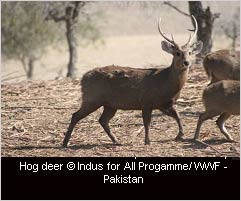 Hog Deer(Axis porcinus)
Hog Deer(Axis porcinus)
Local Name: Para
Status: Vulnerable
Recorded in IFAP site: Pai Forest
Description:
Hog deer are nocturnal animals with short legs and a stocky appearance. Body length is about 1 - 1.15 m, height at shoulders is 60 - 76 cm, tail length 18 - 20 cm and weight is around 36-50 kg. They are brownish in colour, although adult males generally darken with age. The young ones are spotted with white freckles.
Habitat and General Behaviour:
The term “hog deer” is derived from its habit of running through the forest with its head held low, ducking under obstacles in the manner of a wild hog (pig), rather than leaping over them like most deer. When alarmed, they make a whistling sound or give out a warning bark. They can swim well and readily enter the water thus often taking up temporary abode on islands between the channels of the Indus.
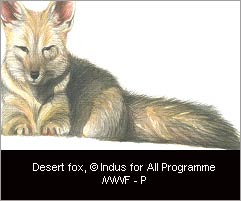 Local Name: Sahrai Loomar
Local Name: Sahrai Loomar
Status: Near Threatened
Recorded in IFAP site: Chotiari
Description:
The body of a Desert Fox is covered with short hair of grayish brown color. Tail is long and bushy with a terminal white tip and back of the ears is usually dark brown.
Habitat and Behaviour:
A sub-species of common red fox (Vulpes vulpes), Desert fox is found in the plains and desert regions of Pakistan. It is a solitary, nocturnal animal that seeks shelter inside the burrow during daytime. A resourceful hunter, it utilizes its acute hearing as well as sense of smell to locate its prey.
Feeding and Breeding Patterns:
Usually feed on rodents but small birds, reptiles, and insects like termites, cockroaches etc. also form part of their diet. They also like to feed on ripe fruits like berries and wild melons etc. Breeds once in a year, gestation period is about 53 days and 4 – 5 pups are born per litter in late winter or early spring.
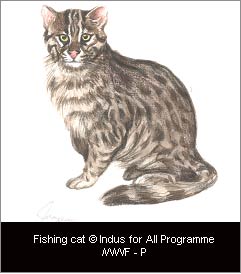 Local Name: Mash Billo
Local Name: Mash Billo
Status: Vulnerable
Recorded in IFAP sites: Keti Bunder, Keenjhar and Chotiari
Description:
Fishing cat has grayish-brown fur with dark brown or black spots and black lines running up the forehead and over the crown of the head. It has a short body with stocky legs. The front feet are partially webbed and claw sheaths are short so that when the claws are retracted they are not completely covered.
Habitat and Behaviour:
Lives near water, and is seldom seen in open areas during day time as it remains hidden in dens, reed beds or riverine forests. It is capable of swimming strongly both on the surface as well as underwater.
Feeding and Breeding Patterns:
Mainly feed on fish but also prey on waterfowl and frogs. Breeding months are January and February. Gestation period lasts up to 63 days and they normally give birth to 2 kittens.
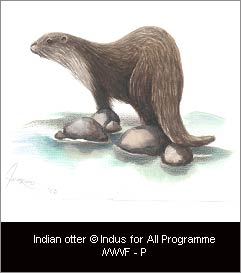 Local Name: Ludher
Local Name: Ludher
Status: Near Threatened
Recorded in IFAP site: Chotriari
Description:
Indian Otter has thick and heavy body with glossy and sandy-brown coloured dorsal fur, while the belly fur is silvery buff. Tail is powerful and muscular. Feet have short blunt claws and the toes are webbed with elastic-like skin
Habitat and Behaviour: A gregarious and social animal hunting cooperatively in groups, travels extensively and defines its territories by its droppings.
Feeding and Breeding Patterns:
Feeds on mainly fish but if available may also feed on frogs, snakes and small mammals. It also catches waterfowl by snatching them from the surface and dragging them under water. Young ones are born in spring after a gestation period of 60 - 63 days while the litter normally numbers 2 - 4 in size. It remains dependent on its mother for 10 - 11 months.
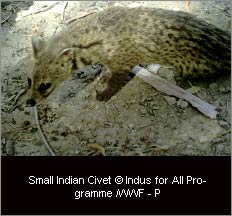 Local Names: Mushk Billa or Kasturi Billa
Local Names: Mushk Billa or Kasturi Billa
Status: Near Threatened
Recorded in IFAP sites: Pai Forest
Description:
Small Indian Civet is an alert and attractive cat-like animal with a pointed, cylindrical muzzle. The body is sandy buff in colour with black spots arranged in horizontal lines. Its claws are sharp, well-developed but non-retractable. It has a scent gland and therefore is locally referred to as Mushk Billa i.e. musk cat. Adults weigh about 3 kg and are about 45 - 63 cm in length. The tail is around 42 cm long.
Habitat and Bahaviour:
It is a nocturnal animal and spends most of the day time sleeping underground in burrows. It prefers to hunt near human habitations and therefore can be found near villages. Being omnivorous in diet, it digs up soil borne insects, lizards and rodents and can climb trees to reach fruit or birds’ nests.
Feeding and Breeding Patterns:
Consumes all types of food like fruits, insects, arthropods, lizards, small birds and mammals. Being nocturnal it often steals domestic poultry to feed on. Due to this the villagers regard this animal as their enemy. Breeding takes place at any time during the year and the litter size is 3 – 5.
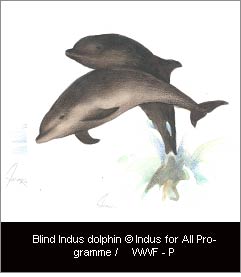 Local Name: Bhulan
Local Name: Bhulan
Status: Endangered
Recorded in: Upstream Sukkur
Physical Description:
A small-sized dolphin with head and body length measuring about 1.35 m and weighing about 18 - 22 kg. It has soft skin and body colour is pale grey. The eyes are degenerate and barely visible hence it is a blind dolphin.
Habitat and General Behaviour:
The Indus dolphin is confined to silt-laden flowing rivers and avoids turbulent areas The dolphins are quite social and have been observed in groups of up to ten. They use an echo-location system of high frequency clicking noises to feel their way around the river and catch their prey. These sonar ‘clicks’ are considered to come from the larynx, and not from the ‘melon’ (forehead bulge) . Feeding and Breeding Habits: Mostly the food consists of cat fish but occasionally they also eat cray fish. Mating occurs in late April and May and young ones are born in March and April after a gestation period of 10 – 11 months.
Feeding and Breeding Patterns:
Food includes foliage of poplar, flowers of Acacia nilotica and berries. It also consumes grasses depending upon availability. Breeding season peaks from August to October. Gestation period lasts for 8 months and usually twins are produced during the months of March to early July.
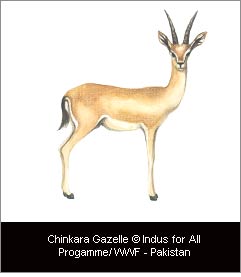 Local Name: Chitka Hiran
Local Name: Chitka Hiran
Status: Vulnerable
Recorded in IFAP site: Chotiari
Description:
Chinkara is a slender creature with delicate looking legs. Its body is covered with pale reddish coloured, short, glossy fur. A fully grown male measures about 65 cm at the shoulder and weighs around 23 kg, and the average horn length varies between 10 to 12 inches (25- 30 cm). The male has 'S' shaped backwardly curved ringed horns, but the female has straight horns usually small, 10-13 cm long and without rings .
Habitat and Behaviour:
Adapted to living in sandy desert as well as low stony hills, it can survive without drinking water for long durations. Being nocturnal in nature, it forages only by night and can cover several kilometers before retreating by early morning to the desert or ravines in hilly areas.
Feeding and Breeding Patterns:
Prefers to eat desert grass, but in winter also feeds on green twigs of Calligonum polygonoides, and leaves of Acacia jacquemontii. It also feeds on cultivated crops like Brassica sp. and Sorghum sp. (Jowar). While breeding takes place twice a year, it usually happens in October and November and young ones are born in April after a gestation period of five and a half months.
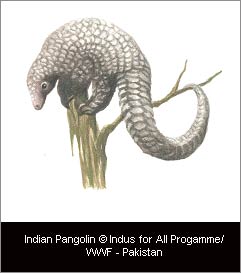 Local Name: Silu
Local Name: Silu
Status: Near Threatened
Recorded in IFAP sites: Keti Bunder and Keenjhar
Description:
This animal has a tiny head, long and narrow snout, and no teeth in its jaws. The body is covered with large, overlapping, bluntly pointed scales. These scales are not present on inside of their limbs. The tail is flat on its underside, rounded from the dorsal and slightly longer than the body. The hind legs bear resemblance to an elephant’s foot, each with five blunt, pinkish white toenails, front two feet have five digits, the middle three ending in enormous claws. It walks on the knuckles of its fore feet to protect these claws.
Habitat and Behaviour:
It is a nocturnal mammal and relies heavily on its sense of smell to detect its food. It can climb up the trees and curls up its body when threatened. Normally solitary, it spends daytime in underground chambers.
Feeding and Breeding Patterns:
Feeds on termites, ants and their eggs. Breeding season is not specified while the gestation period is more than 100 days with normally single birth though twins are also reported.
Local Name: Geedarh
Status: Near Threatened
Recorded in IFAP sites: Keti Bunder, Keenjhar, Pai Forest and Chotiari
Description:
Asiatic jackal looks like a small wolf but differs from it due to its short legs, smaller size, slim muzzle and more bushy tail. The body has coarse fur with sandy-buff appearance, while chest and inner sides of legs are creamy white. The tail is black and ears are small and pointed.
Habitat and Behaviour:
Jackals mostly prefer desert dry open country, arid short grasslands but are also found in areas around human settlements. They are nocturnal in areas inhabited by humans but can be seen in daylight. Usually found in pairs or small groups, they communicate with other members of their group by yelping and barking.
Feeding and Breeding Patterns:
Apart from refuse and carrion they feed on amphibians, reptiles, insects and rodents and fruit. Breeding takes place once a year with gestation period lasting 63 days. Young ones are born during spring and summer and the litter size is 5-7 pups.
Local Name: Lumar
Status: Near Threatened
Recorded in IFAP sites: Keti Bunder and Chotiari
Description:
Bengal fox is usually grayish in colour but some individuals may be silverish grey and yellowish grey also. Tail is 25 – 35 cm long and bushy, with a terminal and conspicuous black tip. Adults measure about 45 - 60 cm in length. Males weigh around 3 kg, whereas females are less than 2 kg.
Habitat and Behaviour:
Nocturnal, solitary, omnivorous, and shelter inside furrows. They hunt by using their acute sense of hearing and smell.
Feeding and Breeding Patterns:
They feed on mainly rodents, lizards like Uromastix, insects including locusts, black ants and scorpions. Depending on availability they also eat melons and fallen fruits. Breeding takes place once a year and 3 - 4 pups are born per litter, after a gestation period of 53 days in either spring or during the monsoon.
Local Name: Siva gush
Status: Critically Endangered
Recorded in IPAF site: Chotiari
Description:
Desert Lynx is a medium-sized cat which is brick-red in color. Belly and inside of lower limbs are creamy-buff, while the areas around lips and chin are whitish. Gracefully built, this cat has a short tail reaching just to the hocks, and long and pointed ears.
Habitat and Behaviour:
Being a nocturnal creature, it seeks shelter during the day in crevices between rocks and hunts mostly at night. It is extremely fast in catching its prey. It can leap into trees to strike down the roosting birds, and can jump into the air to strike down sand grouse and doves. It is considered a major predator of the young Chinkara.
Feeding and Breeding Patterns:
It preys on desert hares, young Chinkara, nocturnal rodents, sand grouse, roosting small birds, reptiles and insects. Breeds once a year and gestation period last up to 67-70 days. The size of the litter size varies from 2 to 6 kittens.
|